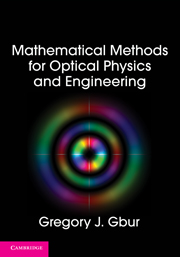Book contents
- Frontmatter
- Contents
- Preface
- 1 Vector algebra
- 2 Vector calculus
- 3 Vector calculus in curvilinear coordinate systems
- 4 Matrices and linear algebra
- 5 Advanced matrix techniques and tensors
- 6 Distributions
- 7 Infinite series
- 8 Fourier series
- 9 Complex analysis
- 10 Advanced complex analysis
- 11 Fourier transforms
- 12 Other integral transforms
- 13 Discrete transforms
- 14 Ordinary differential equations
- 15 Partial differential equations
- 16 Bessel functions
- 17 Legendre functions and spherical harmonics
- 18 Orthogonal functions
- 19 Green's functions
- 20 The calculus of variations
- 21 Asymptotic techniques
- Appendix A The gamma function
- Appendix B Hypergeometric functions
- References
- Index
Preface
Published online by Cambridge University Press: 05 June 2012
- Frontmatter
- Contents
- Preface
- 1 Vector algebra
- 2 Vector calculus
- 3 Vector calculus in curvilinear coordinate systems
- 4 Matrices and linear algebra
- 5 Advanced matrix techniques and tensors
- 6 Distributions
- 7 Infinite series
- 8 Fourier series
- 9 Complex analysis
- 10 Advanced complex analysis
- 11 Fourier transforms
- 12 Other integral transforms
- 13 Discrete transforms
- 14 Ordinary differential equations
- 15 Partial differential equations
- 16 Bessel functions
- 17 Legendre functions and spherical harmonics
- 18 Orthogonal functions
- 19 Green's functions
- 20 The calculus of variations
- 21 Asymptotic techniques
- Appendix A The gamma function
- Appendix B Hypergeometric functions
- References
- Index
Summary
Why another textbook on Mathematical Methods for Scientists? Certainly there are quite a few good, indeed classic texts on the subject. What can another text add that these others have not already done?
I began to ponder these questions, and my answers to them, over the past several years while teaching a graduate course on Mathematical Methods for Physics and Optical Science at the University of North Carolina at Charlotte. Although every student has his or her own difficulties in learning mathematical techniques, a few problems amongst the students have remained common and constant. The foremost among these is the “wall” between the mathematics the students learn in math class and the applications they study in other classes. The Fourier transform learned in math class is internally treated differently than the Fourier transform used in, say, Fraunhofer diffraction. The end result is that the student effectively learns the same topic twice, and is unable to use the intuition learned in a physics class to help aid in mathematical understanding, or to use the techniques learned in math class to formulate and solve physical problems.
To try and correct for this, I began to devote special lectures to the consequences of the math the students were studying. Lectures on complex analysis would be followed by discussions of the analytic properties of wavefields and the Kramers–Kronig relations. Lectures on infinite series could be highlighted by the discussion of the Fabry–Perot interferometer.
Information
- Type
- Chapter
- Information
- Mathematical Methods for Optical Physics and Engineering , pp. xv - xviiiPublisher: Cambridge University PressPrint publication year: 2011
